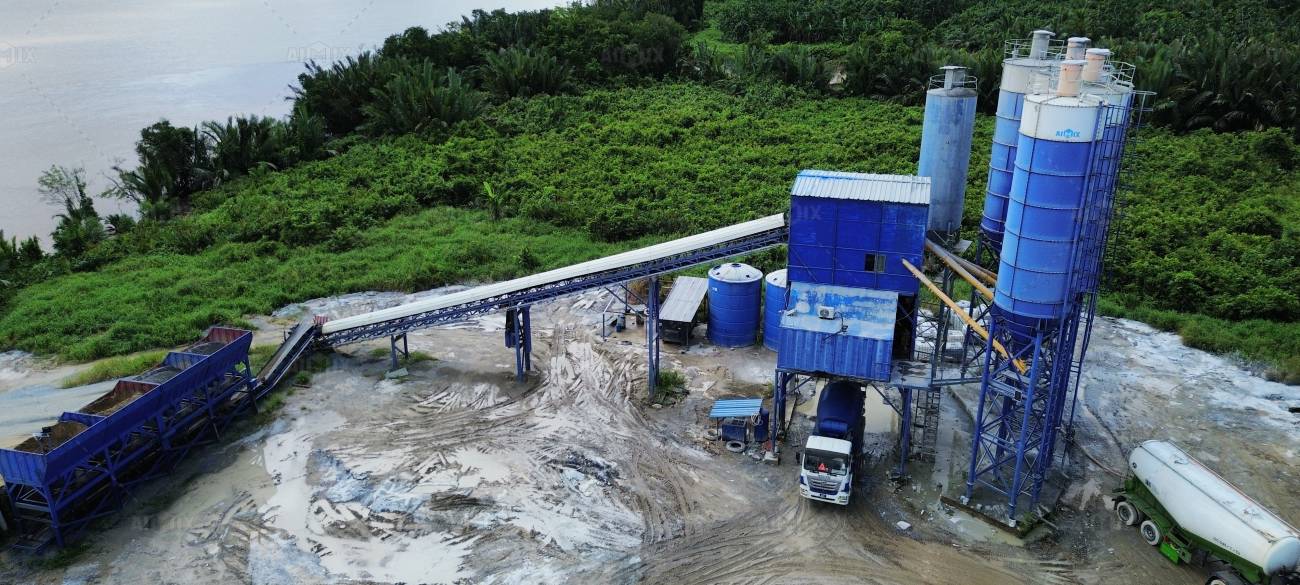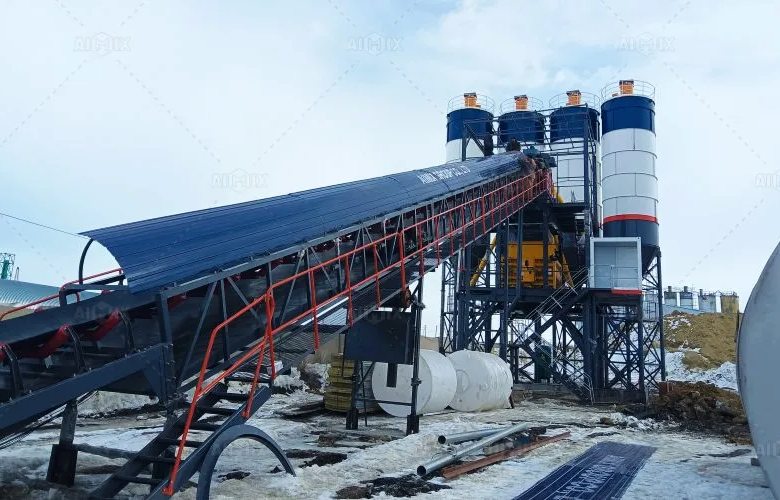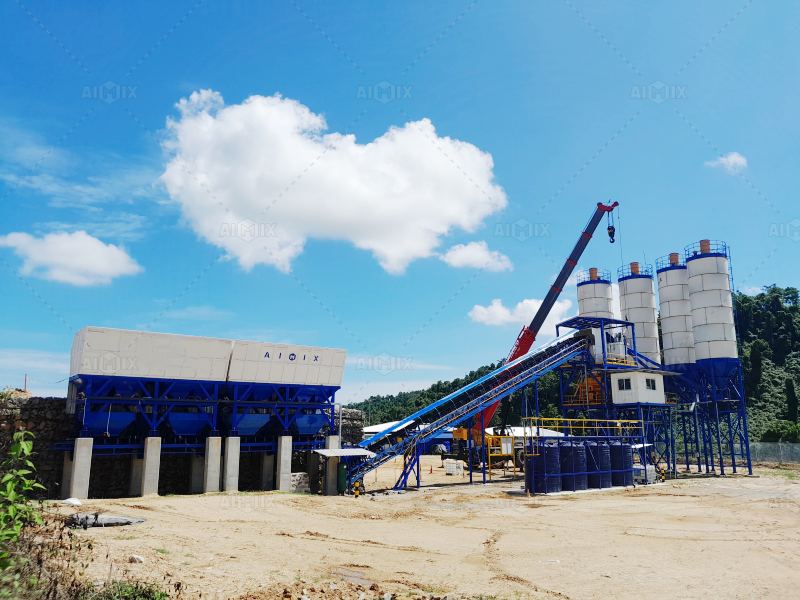Concrete production is the backbone of modern construction projects, providing the essential material needed for everything from residential buildings to large-scale infrastructure projects. One of the key factors in achieving high-quality and consistent concrete is having the right batching plant. A stationary batching plant, in particular, plays a crucial role in optimizing the production process. In this technical guide, we will explore how to optimize concrete production with stationary batching plant, compare them with other types such as mobile concrete batching plants, and discuss the necessary considerations for those looking to start a concrete plant.

What is a Stationary Batching Plant?
A stationary batching plant is a fixed plant used to produce large quantities of concrete at a central location. These plants are designed to mix the various components required to make concrete, including cement, aggregates, water, and additives, in precise proportions. Stationary batching plants typically consist of various components like silos for cement storage, aggregate bins, mixing units, and control systems that ensure the entire process is automated and efficient.
Stationary batching plants are often preferred for large-scale projects due to their higher production capacity, precision, and efficiency. Their design makes them suitable for long-term and large-scale concrete production with a consistent quality output.
Benefits of Stationary Batching Plants
High Production Capacity: Stationary plants are designed to handle high-volume concrete production, making them ideal for large projects, such as roads, highways, and infrastructure developments.
Consistency and Accuracy: With advanced control systems, stationary batching plants can ensure that each batch of concrete is mixed to the precise specification. This leads to high-quality and consistent concrete, which is crucial for structural integrity.
Durability and Reliability: Since stationary concrete mixer plants are designed for heavy-duty use, they tend to be more durable and can operate continuously without significant wear and tear, making them reliable for long-term production.
Automation Features: Modern stationary batching plants often come equipped with automated control systems that allow for real-time monitoring of mixing and batching processes. This enhances operational efficiency and reduces the risk of human error.

Optimizing Concrete Production with Stationary Batching Plants
To achieve optimal concrete production using stationary batching plants, several strategies and technical considerations need to be taken into account:
Efficient Plant Design and Layout
The layout of a stationary batching plant plays a significant role in maximizing productivity. It is important to design the plant with an efficient flow of materials to minimize delays and improve batching speed. Components such as the aggregate bins, cement silos, and water supply systems should be strategically positioned to reduce the distance between them and the mixing unit. This minimizes material handling time and enhances overall plant efficiency.
Proper Calibration and Maintenance
For a stationary batching plant to operate at its best, regular calibration and maintenance are essential. Over time, parts of the plant can wear down or become misaligned, leading to inconsistencies in concrete production. Ensuring that all components, such as the weighing systems, mixers, and conveyors, are regularly calibrated and maintained will prevent production issues and improve the plant’s performance.
Integration of Advanced Control Systems
Automated control systems play a pivotal role in optimizing concrete production. By using sophisticated software, operators can monitor and adjust the production process in real time. These systems also help with tracking inventory, scheduling production, and generating reports for quality control. The ability to make immediate adjustments to the mix ensures that the final product consistently meets the required specifications.
Efficient Material Handling and Storage
Efficient material handling is essential for optimizing production. The aggregate bins, cement silos, and water storage tanks should be appropriately sized and located for easy access. Additionally, a good storage system helps in reducing wastage and maintaining the quality of materials. For instance, storing cement in proper silos will prevent moisture absorption, which could affect the mix quality.
Optimizing Energy Consumption
Energy efficiency is an important aspect of optimizing concrete production. Batching plants should be equipped with energy-efficient equipment such as variable frequency drives (VFDs) for motors and efficient mixers that minimize electricity consumption. Implementing energy-saving practices not only reduces operational costs but also makes the plant more environmentally friendly.
Quality Control Procedures
Concrete quality is paramount, and using the correct mix proportions is key to achieving the desired strength and durability. Stationary batching plants typically have built-in systems that ensure precise measurement and mixing of the ingredients. Regular testing of raw materials and the final product ensures that the concrete produced meets the required standards.

Comparing Stationary Batching Plants with Mobile Concrete Batching Plants
When deciding on the right type of batching plant for a project, it’s important to consider the differences between stationary and mobile concrete batching plant. While stationary plants are ideal for large-scale, long-term projects, mobile concrete batching plants are better suited for smaller, temporary jobs.
Stationary Concrete Batching Plant: As mentioned, stationary plants are fixed at one location and are built for high-volume, continuous production. These plants are suitable for large construction projects where a consistent supply of concrete is required. The high-capacity nature of stationary plants allows them to produce large quantities of concrete efficiently.
Mobile Concrete Batching Plant: Mobile batching plants are more flexible, as they can be easily moved from one site to another. They are typically used for smaller projects, such as residential buildings or road repairs. Mobile plants are compact and less expensive than stationary plants, but they offer lower production capacities. They are ideal for temporary projects where the plant needs to be relocated frequently.
How to Start a Concrete Plant
How to start a concrete plant? Starting a concrete plant requires careful planning and a deep understanding of the market, equipment, and technical needs. Here’s a step-by-step approach to starting a concrete batching plant:
Market Research and Feasibility Study: Understand the local demand for concrete, potential competitors, and the types of projects you’ll be serving. A feasibility study helps in estimating the costs, equipment needed, and the expected return on investment.
Choose the Right Plant Type: Based on your project scope, decide whether a stationary batching plant or a mobile concrete batching plant is more suitable. For large-scale projects with a high demand for concrete, a stationary plant is often the better choice.
Select a Reliable Concrete Mixer Plant: Choose a reputable supplier that offers durable and efficient mixer plants. Depending on your requirements, you can select a ready-mix concrete plant or a specialized concrete mixer plant that suits your production needs.
Install Infrastructure and Equipment: Set up the infrastructure such as aggregate storage, cement silos, water supply systems, and mixing units. Proper installation is essential for smooth operation and high-quality production.
Obtain Permits and Compliance: Ensure that your plant complies with local regulations, including environmental standards and building codes. Obtain the necessary permits for setting up and operating your batching plant.
Hire and Train Operators: Skilled operators are essential for running the batching plant efficiently. Invest in training programs to ensure that your team is well-versed in handling automation systems, quality control, and maintenance.
Conclusion
Optimizing concrete production with stationary batching plants involves a mix of technical considerations, such as plant design, maintenance, automation, and energy efficiency. While stationary plants are ideal for large-scale, long-term projects, mobile batching plants offer flexibility for smaller or temporary projects. Understanding the specific needs of your project and carefully selecting the right plant can significantly improve your concrete production efficiency. For those looking to start a concrete plant, investing in reliable equipment, maintaining high standards, and following industry best practices will ensure long-term success in the competitive construction market.
